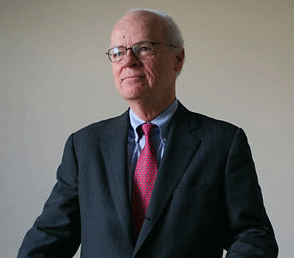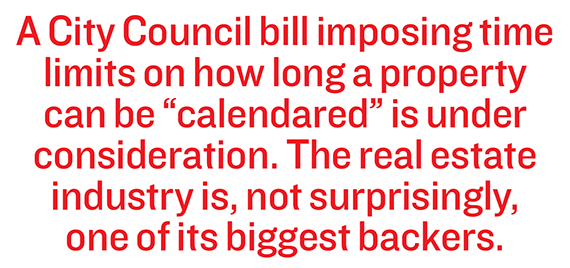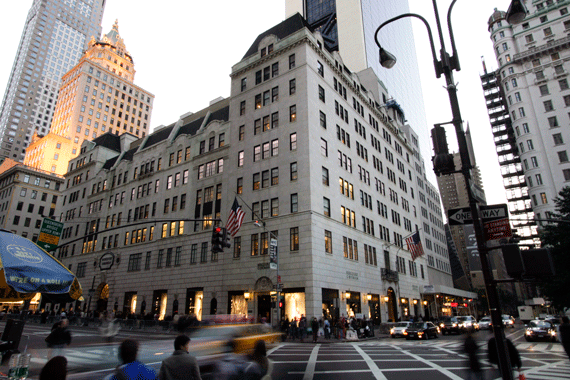While debate about reforming the city’s landmarks process is coming to a head in the City Council, the fate of 95 properties across the five boroughs, including several in prime neighborhoods that could be ripe for potential development, hangs in the balance.
The Landmarks Preservation Commission and the City Council are locked in a struggle over the so-called “clock” for designating a landmark. At issue is how much time the LPC is allotting to decide whether a building should be landmarked. That designation limits developers from altering a building or demolishing it.
A bill imposing time limits on how long a property can be “calendared” — or slated for landmarks consideration — is currently wending its way through committee. And the real estate industry is, not surprisingly, one of its biggest backers. That’s because as New York’s real estate market has grown hotter (both in Manhattan and in the outer boroughs), leaving properties on this list to collect dust has not sat well with developers.
The skirmish over the landmarking clock began in early 2014, when former Landmarks Chairman Robert Tierney admitted that the city agency had allowed 95 city sites — including 32 in Manhattan — to sit in landmark limbo for years, and in many cases decades. The sites had been calendared, as far back as the mid-1960s, but no decisions were made.
The properties on the backlog are assorted in size and type: a row of 10 late 1920s-era homes in Jackson Heights, Queens; all of Green-Wood Cemetery in Brooklyn; the oldest building at Staten Island’s Wagner College; and an 1860 farmhouse on City Island in the Bronx, to name just a few.

Former Landmarks Chairman Robert Tierney
The list also includes a number of Manhattan properties, from churches to private homes to the Bergdorf Goodman department store.
While being stuck on the calendar doesn’t prevent owners from renovating, it requires them to check with the LPC if they want to make any changes.
Late last year, Tierney’s successor, Meenakshi Srinivasan, took a step to address the issue when she moved to “de-calendar” the entire list. That would have removed the properties from landmarks consideration and allowed owners to renovate or tear them down at will. But that set off a firestorm among preservationists, and the agency backed off.
The backlog goes back to a time when the Landmarks law was untested and the newly established LPC was “not in a hurry” to designate a property if the owner opposed it, said Simeon Bankoff, executive director of the Historic Districts Council, a preservation advocacy group. Even today, the LPC prefers to work with owners and win their support when they designate a property, Srinivasan said.
In the early days, calendaring wasn’t as burdensome for property owners because it didn’t prevent them from altering their buildings. As a result, owners put less pressure on the LPC to decide on designations, prompting the list to swell to its current size. That changed in the 1980s when the city instituted a 40-day waiting period for developers seeking permits on these calendared properties.
In an effort to torpedo the council bill, the LPC has taken aggressive action to clear its backlog and neutralize the issue. Last month, it wrapped up a series of hearings in which it considered properties and allowed stakeholders to testify. It has given itself until December 2016 to make final decisions.
In the beginning
In the early 1970s, Rockrose Development Corp. bought James McCreery & Co. department store at 67 East 11th Street. The acquisition transformed Rockrose’s profile and helped start a trend that recast the neighborhood.
The cast-iron building had been on the LPC’s calendar since 1966 and was fire damaged by the time the firm — then run by brothers Henry, Thomas and Frederick Elghanayan — stepped in.
The conventional wisdom of the time was to tear it down and replace it with a modern high-rise, but the Elghanayans were young, receptive to community protests and appreciative of the five-story building’s beauty, Henry Elghanayan told The Real Deal. Working with preservationists at the LPC, the firm converted it into a rental building.
Nevertheless, Rockrose quietly opposed landmark designation, said Elghanayan, who now heads Rockrose with his son Justin. (His brothers split off and run TF Cornerstone.)
“It puts constraints on you … slows down the process, even if you have a cordial relationship” with Landmarks officials, Elghanayan said. “We showed them the plans of what we were going to do, and then we did what we said we would do.”
When it became obvious that the renovated building, whose units with Corinthian columns running through the middle of living spaces were particularly popular, was no longer in jeopardy, the agency let the issue of landmarking drop, Elghanayan said. But it remained on Landmarks’ calendar. The Elghanayans no longer own the building, which was eventually converted into a co-op. The City Council’s scrutiny has prompted LPC to race to process the backlog.

The LPC’s goal is to show the council, which has final say on landmark designations, that further regulation is unnecessary. The bill — which is being sponsored by Queens Councilman Peter Koo and Brooklyn Councilman David Greenfield, who chairs the powerful Land Use Committee — would require the LPC to take action on the 95 backlogged sites within 18 months and to make decisions on newly proposed landmarks within a year of being calendared. (The commission would get two years to make decisions about historic districts, which typically include multiple blocks and a number of buildings.)
The bill also includes a controversial moratorium that would block the LPC from changing its mind for five years if it opts to pass on designating a building.

John Banks
Under current law, once the LPC passes, its owners can do whatever they want, but the agency can also reconsider its decision. Critics of the moratorium argue it would give owners a perverse incentive to tear down buildings within that five-year span, to prevent the possibility of the agency circling back to the property and landmarking it.
Last month, the bill remained in committee and was “in the process of being amended,” possibly to include a shorter moratorium, a person familiar with the legislative process told TRD.
Meanwhile, the Real Estate Board of New York; the Roman Catholic Archdiocese of New York, which owns a number of backlogged properties; and construction unions are pushing to get it green-lighted.
In April, REBNY President John Banks argued that those opposed to the construction of tall, modern buildings are using the Landmarks law to circumvent “the more thorough and comprehensive zoning process.”
In a column, published on REBNY’s website, Banks referred to landmarking entire districts as “encasing large portions of our dynamic city in amber” and called for “more predictability and transparency in the landmarking process.”
